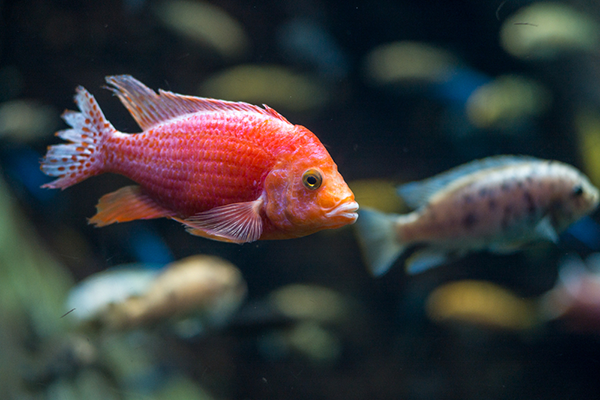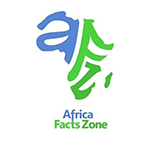Cichlids in Lake Tanganyika – Africa Facts Zone

Cichlids in Lake Tanganyika are the absolute most fascinating African cichlids around, going from the shell-staying Lamprologus species to the weighty Cyphotilapia Frontosa which can reach at” at least 12.
Lake Tanganyika is the second deepest lake on The planet and is situated in central Africa.
Lake Tanganyika is the longest lake in Eastern Africa, extending 420 miles from north to south. It is assessed to be the second biggest freshwater lake on the planet by volume and the second most deepest behind Lake Baikal, the Vote based Republic of the Congo, Burundi, and Zambia.
Lake Tanganyika is home to no less than 250 types of cichlids and 75 or so types of non-cichlid fish.
Cichlids in Lake Tanganyika range from mildly aggressive to aggressive fighters. Numerous species are significantly less aggressive than their Lake Malawian cousins and can succumb to the aggressive Malawi mbuna if kept together.

Also Read: Lake in Malawi: The lake with the the greatest number of fish species on Earth
The 10 Most Famous Cichlids in Lake Tanganyika
The Lemon Cichlid (Neolamprologus leleupi)
is maybe the most popular cichlid to have at any point come from Lake Tanganyika, which owes its notoriety in view of its generally sought-after splendid yellow/orange shading. It’s not just extremely fascinating, it also comes in varieties from dazzling yellow to orange or even dim variety assortment!
This fish is best left in an aquarium with experienced hands. However, it very well may be really taken care of by transitional cichlid darlings.
Pixie Cichlid (Neolamprologus brichardi)
The Pixie Cichlids in Lake Tanganyika is a captivating fish that was one of the main African Tanganyika cichlids imported for our aquariums. It was initially known as Princess of Burundi, yet today you can track down numerous other normal names for this fish: Pixie Cichlid or Brichardi Cichlid.
The Pixie Cichlid has a stretched body and ceaseless dorsal balance. They additionally have lyre-formed tail balances, long streaming fibers on all unpaired blades that can grow up to 6 inches(15 cm) long.
These fish are known for their rich appearance and appreciate living in groups. They make an optimal expansion to any aquarium, regardless of whether you’re simply beginning!
Daffodil Cichlid(Neolamprologus pulcher)
The Daffodil Cichlids in Lake Tanganyika is a pleasant Tanganyika fish animal variety to possess. It is one of the most energetically beautiful cichlids in the African rift, and has a light-shaded tan body tinge with traces of yellow and pale blue spots. The brilliant and frigid blue eye is encircled by a yellowish ring, while its balances are tipped with a cold blue.
Like the Pixie Cichlids, they can grow up to 6 inches (15 cm) long with legitimate consideration. They are tutoring fish that matches off to raise, so they’re best kept in groups.
Calvus Cichlid (Altolamprologus calvus)
Also known as White Silvery Calvus, the Calvus Cichlids in Lake Tanganyika is an exceptional cichlid. It has a place with the Altolamprologus variety, which has three distinguished species and various variations. These fish are cave spawners, however once in a while they breed in packs.
Calvus Cichlids have a lofty brow and high back. They’re ready to uncover prey from rocks or fissure with their along the side packed body, making them one of the most effective fish for hunting food in hard-toed conditions.
They are somewhat serene fish that can be kept with other Tanganyika cichlids of comparable size. Be that as it may, they’re best kept in an animal varieties tank if you have any desire to raise them. They can live with serene cichlids of an alternate class.
Frontosa Cichlid(Cyphotilapia frontosa)
Otherwise called Humphead Cichlids in Lake Tanganyika, this fish is a lofty presence in any aquarium. A full grown Frontosa Cichlid can arrive at up to 14 inches (35 cm) or more. With its huge size, rich, intense examples, and packed body shape, it was promptly viewed as one of the top picks of Tanganyika cichlids reproducers.
The two guys and females have a similar appealing tinge, however just grown-ups foster a cranial protuberance on its head. Adolescents don’t show this attribute since it requires investment for them to grow adequately up.
No doubt about it, Frontosa Cichlids are secretive hunters that will grab up any little fish they can find. They are not exceptionally aggresive, however the guys can be regional.
Duboisi Cichlid (Tropheus duboisi)
The Duboisi Cichlids in Lake Tanganyika (Tropheus duboisi) is an intriguing fish to watch grow up in view of its astounding variety change. It begins its life as a boring dim fish however leisurely procures an ever increasing number of bright markings as it develops.
The sex of the White Spotted Cichlid is a test to decide. Development rate and body shape can be marginally unique among guys and females, yet they don’t recount the entire story. The most solid way is by looking at its genital papillae. The guys have sharp genital, while females are balanced in shape!
The Tropheus duboisi is one of the most aggresive Tanganyika cichlids.
Sardine Cichlid(Cyprichromis leptosoma)
The Sardine Cichlids in Lake Tanganyika(Cyprichromis leptosoma) is an extraordinary expansion to any Lake Tanganyika tank. Dissimilar to most different cichlids that have an appearance of being profound bodied and hearty looking – this fish in the Cyprichromis variety has the inverse; its long slim body makes them seem as though they’re riding on top water.
The body tinge of a male Sardine Cichlid goes from lavender to blue; females accompany a beige body for certain yellow in their balances. The shades of these animals fluctuate contingent upon where they are found.
Sardine Cichlid is not difficult to really focus on and furthermore genuinely serene. They can be kept with other Tanganyika cichlids of comparative size yet ought not be housed with aggresive fish. In the event that you’re searching for a somewhat undemanding Lake Tanganyika Cichlid that adds a ton of varieties, we suggest trying these fish out.
Blue Neon Cichlid (Paracyprichromis nigripinnis)
With a delicate nature and energetic variety, the Blue Neon Cichlids are outright shockers! These eye-getting fish is shrouded in a few splendid varieties neon striping that look perfect against on a velvety body.
The Blue Neon Cichlids have a fundamentally the same as body shape to their direct relations Sardine Cichlid, however they have a place with the Paracyprichromis class, which has an entirely unexpected nature, including a milder personality and more modest body size. The male Blue Neon Cichlids can develop to around 4 crawls long, while females are a piece more modest at a little more than 3 inches.
In spite of the fact that it is a more serene Lake Tanganyika cichlid, this species can be a major test to really focus on by fledglings as they will generally be worried and blur in variety when kept with other uproarious fish.
Blue Goby Cichlid(Spathodus erythrodon)
The Blue Goby Cichlids in Lake Tanganyika is a delightful animal groups with brilliant shading. With tanish dark scales and lines of spots decked out to assist it with mixing in with the environmental elements. It’s otherwise called Blue Lips Goby Cichlid. As its name would suggest, the blue lips stir things up in your cichlid aquarium.
In any case, that is not what makes the fish extraordinary. They’re brilliant with characters to coordinate! These cichlid’s #1 leisure activities is hopping near and playing find the stowaway game in the aquarium.
With regards to mindful, the Blue Goby Cichlids are not difficult to direct to really focus on the grounds that they are delicate and demanding about their current circumstance. This species likes to remain at the highest point of the water segment, and they can coexist with other goby cichlids.
Blunthead Cichlid (Tropheus moorii)
Here is one more one-of-a-kind sort of Tanganyika Tropheus Cichlids. It has been accounted for that the Blunthead Cichlid contains around 50 different variety, it is a genuine hero of assortment. Adored for their brilliant variety assortments, the Blunthead Cichlid can’t be missed.
These stocky fish have a bigger head, under-threw mouth, fan-formed caudal balance, and the body limits towards the caudal peduncle. The back pieces of the dorsal, balances and other significant spots are shrouded in sharp beams to keep hunters under control.
The Blunthead Cichlids can arrive at up to 6 creeps long. In the same way as other Cichlid species, Blunthead Cichlids are very forceful fish. They are for the most part kept in gatherings, females will assist with weakening the male’s forcefulness. Their exceptionally forceful nature and are defenselessness to “bulge” make them a piece hard to keep.
Also Read: Cichlids in Lake malawi’ A Heaven for Cichlids
Complete List of Lake Tanganyika Cichlid Species
| Genus | Species |
| Altolamprologus | Altolamprologus calvus Altolamprologus compressiceps Altolamprologus sp. “Compressiceps Shell” Altolamprologus fasciatus |
| Aulonocranus | Aulonocranus dewindti |
| Baileychromis | Baileychromis centropomoides |
| Bathybates | Bathybates fasciatus Bathybates ferox Bathybates graueri Bathybates horni Bathybates leo Bathybates minor Bathybates vittatus |
| Benthochromis | Benthochromis melanoides Benthochromis tricoti |
| Boulengerochromis | Boulengerochromis microlepis |
| Callochromis | Callochromis macrops Callochromis melanogostigma Callochromis pleurospilus Callochromis stappersii |
| Cariapharynx | Cariapharynx schoutedeni |
| Chalinochromis | Chalinochromis brichardi Chalinochromis popelini Chalinochromis sp. “Bifrenatus” Chalinochromis sp. “Ndobhoi” |
| Ctenochromis | Ctenochromis benthicola Ctenochromis horii |
| Cunningtonia | Cunningtonia longiventralis |
| Cyathopharynx | Cyathopharynx foai Cyathopharynx furcifer Cyathopharynx cf. furcifer |
| Cyphotilapia | Cyphotilapia frontosa Cyphotilapia gibberosa Cyphotilapia sp. “North” |
| Cyprichromis | Cyprichromis leptosoma Cyprichromis leptosoma sp. “Leptasoma Goldfin” Cyprichromis leptosoma sp. “Leptasoma Jumbo” Cyprichromis leptosoma sp. “Leptasoma Kibige” Cyprichromis microlepidotus Cyprichromis pavo Cyprichromis zonatus |
| Ectodus | Ectodus descampsi Ectodus descampsi sp. “Descampsi North” |
| Enantiopus | Enantiopus melanogenys Enantiopus sp. “Kilesa” |
| Eretmodus | Eretmodus cyanostictus Eretmodus sp. “Cyanostictus North” |
| Gnathochromis | Gnathochromis permaxillaris Gnathochromis pfefferi |
| Grammatotria | Grammatotria lemairii |
| Greenwoodochromis | Greenwoodochromis bellcrossi Greenwoodochromis christyi |
| Haplotaxodon | Haplotaxodon microlepsis Haplotaxodon trifasciatus |
| Hemibates | Hemibates stenosoma |
| Interchromis | Interchromis loocki |
| Julidochromis | Julidochromis dickfeldi Julidochromis marlieri Julidochromis ornatus Julidochromis regani Julidochromis sp. “Chisanza Marmelade” Julidochromis sp. “Congo” Julidochromis sp. “Kissi” Julidochromis sp. aff. “Ornatus Kasenga” Julidochromis transcriptus |
| ‘Lamprologus’ | ‘Lamprologus’ brevis ‘Lamprologus’ callipterus ‘Lamprologus’ calliurus ‘Lamprologus’ caudopuntatus ‘Lamprologus’ sp. “Caudopuntatus Kipili” ‘Lamprologus’ finalimus ‘Lamprologus’ multifasciatus ‘Lamprologus’ ocellatus ‘Lamprologus’ ornatipinnis ‘Lamprologus’ sp. aff. “Ornatipinnis Tembwe II” ‘Lamprologus’ sp. “Ornatipinnis Zambia” ‘Lamprologus’ sp. “Shell Zambia” ‘Lamprologus’ similis ‘Lamprologus’ speciosus ‘Lamprologus’ stappersi ‘Lamprologus’ wauthioni |
| Lepidiolamprologus | Lepidiolamprologus attenuatus Lepidiolamprologus boulengeri Lepidiolamprologus sp. aff. “Boulengeri” Lepidiolamprologus elongatus Lepidiolamprologus hecqui Lepidiolamprologus sp. “Hecqui Boulengeri Complex” Lepidiolamprologus kendalli Lepidiolamprologus lemairii Lepidiolamprologus meeli Lepidiolamprologus sp. “Meeli” Lepidiolamprologus pleuromaculatus Lepidiolamprologus profundicola Lepidiolamprologus sp. “Profundicola” |
| Lestradea | Lestradea perspicax |
| Limnochromis | Limnochromis abeelei Limnochromis auritus Limnochromis staneri |
| Limnotilpia | Limnotilapia dardenni |
| Lobochilotes | Lobochilotes labiatus |
| Microdontochromis | Microdontochromis rotundiventralis Microdontochromis tenuidentatus |
| Neolamprologus | Neolamprologus bifasciatus Neolamprologus brichardi Neolamprologus cf. brichardi Neolamprologus buescheri Neolamprologus christyi Neolamprologus crassus Neolamprologus cunningtonia Neolamprologus cylindricus Neolamprologus sp. “Eseki” Neolamprologus falcicula Neolamprologus furcifer Neolamprologus gracilis Neolamprologus kungweensis Neolamprologus laparogramma Neolamprologus leleupi Neolamprologus cf. leleupi Neolamprologus longicaudatus Neolamprologus marunguensis Neolamprologus modestus Neolamprologus mondabu Neolamprologus mustax Neolamprologus niger Neolamprologus nigriventris Neolamprologus obscurus Neolamprologus pectoralis Neolamprologus petricola Neolamprologus prochilus Neolamprologus pulcher Neolamprologus savoryi Neolamprologus schreyeni Neolamprologus sexfasciatus Neolamprologus signatus Neolamprologus splendens Neolamprologus cf. splendens Neolamprologus tetracanthus Neolamprologus toae Neolamprologus tretocephalus Neolamprologus variostigma Neolamprologus sp. aff. “Variostigma” Neolamprologus ventralis |
| Ophtalmotilapia | Ophthalmotilapia boops Ophthalmotilapia heterodonta Ophthalmotilapia nasuta Ophthalmotilapia ventralis |
| Oreochromis | Oreochromis tanganicae |
| Paracyprichromis | Paracyprichromis brieni Paracyprichromis nigripinnis Paracyprichromis sp. aff. “Nigripinnis” |
| Perissodus | Perissodus eccentricus Perissodus microlepis |
| Petrochromis | Petrochromis ephippium Petrochromis sp. “Ephippium” Petrochromis famula Petrochromis fasciolatus Petrochromis sp. “Kipili Brown” Petrochromis macrognathus Petrochromis sp. “Macrognathus” Petrochromis orthognathus Petrochromis sp. “Orthognathus” Petrochromis polyodon Petrochromis sp. “Polyodon” Petrochromis sp. “Red” Petrochromis trewavasae Petrochromis sp. “Yellow” |
| Plecodus | Plecodus elaviae Plecodus multidentatus Plecodus paradoxus Plecodus straeleni |
| Pseudosimochromis | Pseudosimochromis curvifrons |
| Reganochromis | Reganochromis calliurus |
| Simochromis | Simochromis babaulti Simochromis diagramma Simochromis loocki Simochromis margaretae Simochromis marginatus |
| Spathodus | Spathodus erythrodon Spathodus marlieri |
| Tangachromis | Tangachromis dhanisi |
| Tanganicodus | Tanganicodus irsacae |
| Telmatochromis | Telmatochromis bifrenatus Telmatochromis sp. aff. “Bifrenatus” Telmatochromis brachygnathus Telmatochromis brichardi Telmatochromis burgeoni Telmatochromis dhonti Telmatochromis sp. “Schachbrett” Telmatochromis temporalis Telmatochromis sp. “Temporalis Shell” Telmatochromis vittatus Telmatochromis sp. aff. “Vittatus” |
| Trematocara | Trematocara caparti Trematocara kufferathi Trematocara macrostoma Trematocara marginatum Trematocara nigrifrons Trematocara stigmaticum Trematocara unimaculatum Trematocara variabile Trematocara zebra |
| Trematochromis | Trematochromis schreyeni |
| Triglachromis | Triglachromis otostigma |
| Tropheus | Tropheus annectens Tropheus sp. “Black” Tropheus brichardi Tropheus duboisi Tropheus sp. “Ikola” Tropheus moorii Tropheus sp. “Mpimbwe” Tropheus sp. “Red” |
| Tylochromis | Tylochromis polylepis |
| Variabilichromis | Variabilichromis moori |
| Xenochromis | Xenochromis hecqui |
| Xenotilapia | Xenotilapia bathyphila Xenotilapia boulengeri Xenotilapia burtoni Xenotilapia caudifasciata Xenotilapia flavipinnis Xenotilapia sp. “Fluorescent Green” Xenotilapia leptura Xenotilapia longispinis Xenotilapia nasus Xenotilapia nigrolabiata Xenotilapia ochrogenys Xenotilapia sp. “Ochrogenys Ndole” Xenotilapia ornatipinnis Xenotilapia papilio Xenotilapia sp. aff. “Papilio Katete” Xenotilapia sp. aff. “Papilio Sunflower” Xenotilapia sp. “Red Princess” Xenotilapia rotundiventralis Xenotilapia sima Xenotilapia spiloptera Xenotilapia tenuidentatus |
Conclusion
From Tanganyika Tropheus Cichlids to Tanganyika Goby Cichlids, there’s a wide assortment of cichlids to browse while loading your Tanganyika aquarium. With such lovely and novel fish, it’s not difficult to see the reason why aquarists are attracted to the Lake Tanganyika environment.
We trust this rundown assists you with tracking down the ideal Lake Tanganyika Cichlid for your aquarium. Assuming you have any inquiries concerning the aide or anything connected with it, go ahead and message us straightforwardly. We’re consistently anxious for criticism from our perusers!





